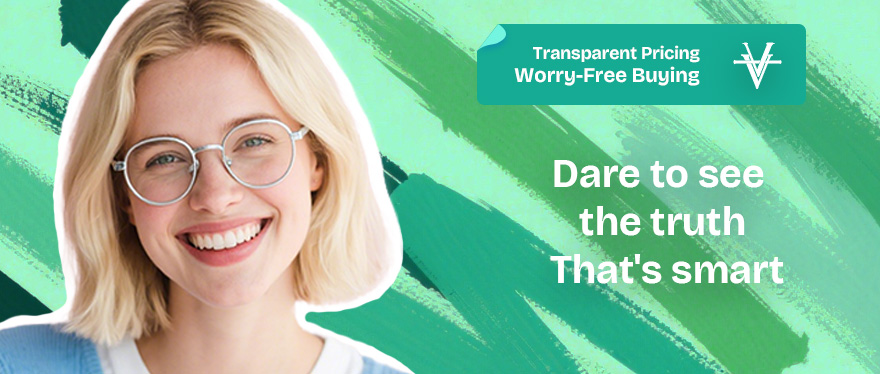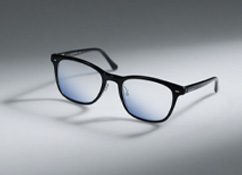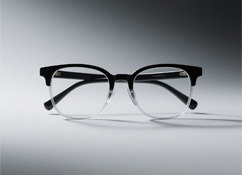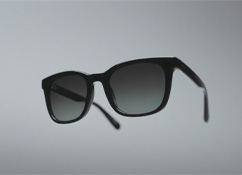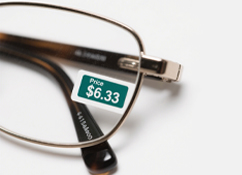What High-Tech Materials Are in Blue Light Blocking Lenses? A Deep Dive
When I grew up, my parents had little standoffs with me to stop me from watching too much TV—they were terrified it’d ruin my eyes. Now, it’s not just TVs: phones, tablets, laptops—screens are everywhere. We can’t avoid them, but we can protect our eyes from the blue light they emit.
Blue light from screens carries lots of energy, and long-term exposure takes a real toll on eye health. Studies show short-wavelength blue light triggers oxidative stress in the retina, and over time, it raises the risk of age-related macular degeneration (AMD). The solution? Blue light blocking lenses—but what high-tech materials make them work? Let’s break it down.
First: Why Blue Light Blocking Lenses Matter
Not all blue light is bad:
Harmful short-wavelength blue light (415–455nm): Damages retinal cells, increasing AMD risk and causing eye strain.
Beneficial long-wavelength blue light (470–500nm): Regulates your circadian rhythm (sleep-wake cycle) and boosts mood.
Good blue light blocking lenses filter out 20–40% of the harmful stuff while keeping the beneficial blue light intact. They also often shield against UV rays and reduce screen-related eye fatigue—key for anyone staring at screens 4+ hours a day.
Key Materials in Blue Light Blocking Lenses
Over 70% of prescription glasses use resin lenses—and their molecular structure is what makes blue light protection possible. Here are the most common resin materials, plus how they perform:
1. Resin Substrates: The Foundation
Resin lenses rely on three main materials, each with unique optical properties:
Material Full Name Light Transmittance Refractive Index Thermal Stability (Tg) Key Perks
CR-39 Polydiallyl glycol carbonate Up to 92% 1.49 120°C Affordable, great clarity, low chromatic aberration
PC (Polycarbonate) Polycarbonate 88–90% (needs coating) 1.59 145°C Shatterproof, lightweight—ideal for kids/active users
MR Series (e.g., MR-174) High-performance resin (e.g., MR-174) 90–91% 1.74 >160°C (with modification) Ultra-thin (great for strong prescriptions), durable
All three have conjugated double bonds and polar groups in their molecular chains—these let them absorb or reflect blue light without ruining vision quality.
2. Blue Light Blocking Additives
To boost protection, manufacturers add two types of ingredients to the resin:
Organic absorbers: Compounds like azobenzene derivatives (e.g., BPA-1) absorb harmful blue light (400–450nm) via chemical reactions (π-π bond transitions). The downside? They often give lenses a slight dark tint (you’ll notice a faint hue).
Inorganic nanoparticles: Tiny cerium oxide (CeO₂) particles (5–10nm wide) mix into the resin. They selectively soak up high-energy blue light while keeping the “Abbe number” (a measure of chromatic aberration) above 40—meaning less blurriness around lens edges.
3. Coatings: The Extra Layer of Protection
Many lenses add a special coating to enhance blue light blocking—especially PC lenses (which have lower natural transmittance). The most common coating tech:
Multi-layer dielectric coatings: Brands like Zeiss use 7-layer coatings that rely on “light interference” to reflect harmful blue light (415–455nm). They’re precise—they let beneficial blue light (470–500nm) pass through, so colors don’t look distorted.
Nanoporous coatings: A middle layer with 50–100nm pores scatters harmful blue light, reducing how much reaches your retina. It’s lightweight and doesn’t add bulk to the lens.
Green Coating vs. Blue Coating: Which Is Better?
You might see blue light lenses labeled “green coating” or “blue coating”—here’s the difference:
Green coating: Absorbs more harmful blue light (up to 35%) and has a subtle green tint. It’s great for people with sensitive eyes or who work night shifts (since it doesn’t disrupt sleep as much).
Blue coating: Reflects blue light instead of absorbing it, so it has a faint blue sheen. It’s better for people who need accurate color vision (e.g., graphic designers) because it distorts colors less.
Neither is “better”—it depends on your needs. If you prioritize maximum protection, go green; if color accuracy matters, blue is better.
Current Tech Challenges (And Future Fixes)
Blue light lenses work well, but they’re not perfect. Here’s what’s holding them back—and what’s next:
Today’s Limitations
Protection vs. transmittance trade-off: Block more blue light, and lenses get darker. If you block over 40%, the “yellowness index” (how yellow the lens looks) goes above 5—making it hard to see true colors.
Coating durability: Reflective coatings can scratch or peel over time (especially if you clean lenses with paper towels). Scratches mean less protection.
PC lens flaws: PC lenses need coatings for blue light protection, but those coatings have low surface hardness—they scratch easily, even with a microfiber cloth.
Future Innovations
Scientists are already working on solutions to fix these issues:
Dynamically responsive materials: Lenses that combine “photochromic” (light-sensitive) properties with blue light blocking. They’ll automatically adjust tint based on how much blue light is around—darker outdoors, lighter indoors.
Plant-based biodegradable resins: Using materials like polylactic acid (PLA) (made from corn starch) with blue light-absorbing groups built into the molecular chain. These are eco-friendly and integrate protection into the lens (no need for coatings).
Metasurface tech: Tiny nanoscale structures on the lens surface that use “plasmonic resonance” to target specific blue light wavelengths. This could let lenses block harmful blue light without any tint or color distortion—game-changing for anyone who hates yellow lenses.
FAQ: Blue Light Blocking Lens Materials
Q: Are CR-39 or PC lenses better for blue light protection?
A: PC is more impact-resistant, but CR-39 has better natural light transmittance. Both work—just make sure PC lenses have a blue light coating. For strong prescriptions, MR-series resins (like MR-174) are best (they’re thin and protective).
Q: Do blue light lenses always have a yellow tint?
A: Not always. Lenses with organic absorbers often have a faint tint, but multi-layer dielectric coatings (like Zeiss’s) can be nearly clear—they reflect blue light instead of absorbing it.
Q: How long do blue light coatings last?
A: With proper care (cleaning with water and a microfiber cloth), coatings last 1–2 years. Avoid alcohol-based wipes—they break down the coating over time.
Final Thought
Blue light blocking lenses have come a long way—from simple resin additives to high-tech nanocoatings. As we spend more time on screens, materials science will keep evolving to balance protection, clarity, and sustainability. The key? Choose lenses that fit your lifestyle (e.g., PC for kids, MR-174 for strong prescriptions) and prioritize coatings that are durable and color-friendly. Your eyes will thank you.
